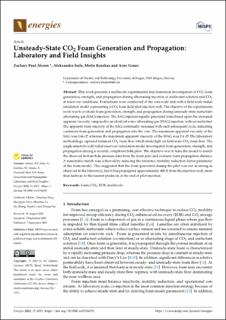| dc.contributor.author | Alcorn, Zachary Paul | |
| dc.contributor.author | Sæle, Aleksandra Magdalena | |
| dc.contributor.author | Karakas, Metin | |
| dc.contributor.author | Graue, Arne | |
| dc.date.accessioned | 2022-10-07T08:29:07Z | |
| dc.date.available | 2022-10-07T08:29:07Z | |
| dc.date.created | 2022-09-09T14:40:15Z | |
| dc.date.issued | 2022-09-07 | |
| dc.identifier.issn | 1996-1073 | |
| dc.identifier.uri | https://hdl.handle.net/11250/3024437 | |
| dc.description.abstract | This work presents a multiscale experimental and numerical investigation of CO2 foam generation, strength, and propagation during alternating injection of surfactant solution and CO2 at reservoir conditions. Evaluations were conducted at the core-scale and with a field-scale radial simulation model representing a CO2 foam field pilot injection well. The objective of the experimental work was to evaluate foam generation, strength, and propagation during unsteady-state surfactant-alternating-gas (SAG) injection. The SAG injection rapidly generated foam based upon the increased apparent viscosity compared to an identical water-alternating-gas (WAG) injection, without surfactant. The apparent foam viscosity of the SAG continually increased with each subsequent cycle, indicating continued foam generation and propagation into the core. The maximum apparent viscosity of the SAG was 146 cP, whereas the maximum apparent viscosity of the WAG was 2.4 cP. The laboratory methodology captured transient CO2 foam flow which sheds light on field-scale CO2 foam flow. The single-injection well radial reservoir simulation model investigated foam generation, strength, and propagation during a recently completed field pilot. The objective was to tune the model to match the observed bottom hole pressure data from the foam pilot and evaluate foam propagation distance. A reasonable match was achieved by reducing the reference mobility reduction factor parameter of the foam model. This suggested that the foam generated during the pilot was not as strong as observed in the laboratory, but it has propagated approximately 400 ft from the injection well, more than halfway to the nearest producer, at the end of pilot injection. | en_US |
| dc.language.iso | eng | en_US |
| dc.publisher | MDPI | en_US |
| dc.rights | Navngivelse 4.0 Internasjonal | * |
| dc.rights.uri | http://creativecommons.org/licenses/by/4.0/deed.no | * |
| dc.title | Unsteady-State CO2 Foam Generation and Propagation: Laboratory and Field Insights | en_US |
| dc.type | Journal article | en_US |
| dc.type | Peer reviewed | en_US |
| dc.description.version | publishedVersion | en_US |
| dc.rights.holder | Copyright 2022 the authors | en_US |
| dc.source.articlenumber | 6551 | en_US |
| cristin.ispublished | true | |
| cristin.fulltext | original | |
| cristin.qualitycode | 1 | |
| dc.identifier.doi | 10.3390/en15186551 | |
| dc.identifier.cristin | 2050357 | |
| dc.source.journal | Energies | en_US |
| dc.identifier.citation | Energies. 2022, 15 (18), 6551. | en_US |
| dc.source.volume | 15 | en_US |
| dc.source.issue | 18 | en_US |

